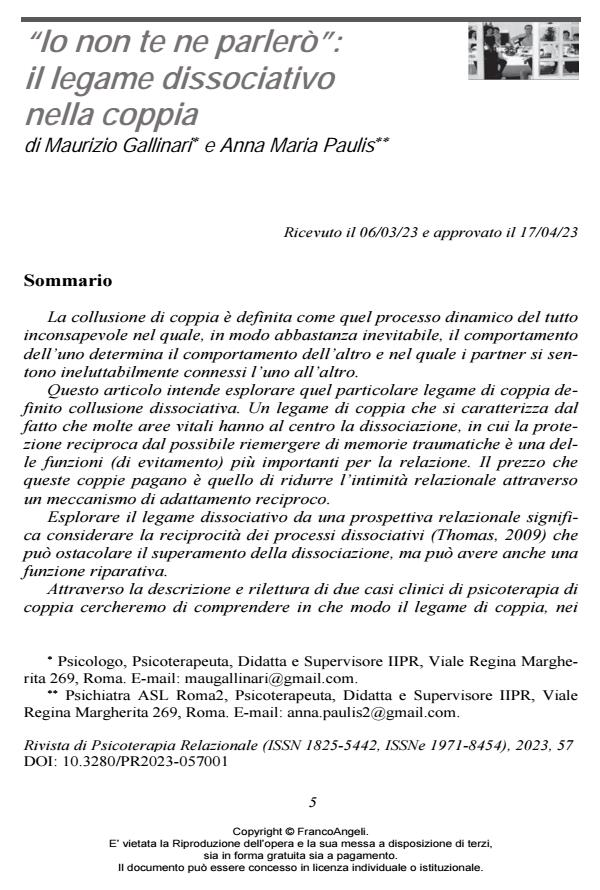"I will not tell you about it": the dissociative bond in the couple
Journal title RIVISTA DI PSICOTERAPIA RELAZIONALE
Author/s Maurizio Gallinari, Anna Maria Paulis
Publishing Year 2023 Issue 2023/57
Language Italian Pages 24 P. 5-28 File size 251 KB
DOI 10.3280/PR2023-057001
DOI is like a bar code for intellectual property: to have more infomation
click here
Below, you can see the article first page
If you want to buy this article in PDF format, you can do it, following the instructions to buy download credits

FrancoAngeli is member of Publishers International Linking Association, Inc (PILA), a not-for-profit association which run the CrossRef service enabling links to and from online scholarly content.
Couple collusion is defined as that completely unconscious dynamic process in which, quite inevitably, the behavior of one determines the behavior of the other and in which the partners feel ineluctably con-nected to each other. This article intends to explore that bond termed dissociative collu-sion. A couple bond which is characterized by the fact that many vital areas have dissociation at the center, in which mutual protection from the possible re-emergence of traumatic memories is one of the most important (avoidance) functions for the relationship. The price these couples pay is to reduce the relational intimacy through a mechanism of mutual adaptation. Exploring the dissociative bond from a relational perspective means considering the reciprocity of dissociative processes (Thomas, 2009) which can hinder the overcoming of dissociation but can also have a reparative function. Through the description and re-reading of two clinical cases of couple psychotherapy we will try to understand how the couple’s bond, in psychotherapeutic contexts, can be the background to the process of healing from trauma. As we will see, the aim is to show how, starting from a collusive and dissociative bond, the couple is able to deal more authentically with the traumatic stories that concern them as individuals. It is often the shared story that activates growth and recovery. In this way the couple will be able to appropriate the dimension of intimacy or find an adult way to get out of the collusion.
Keywords: dissociative collusion, couple interlocking, dissociative bonding, traumatic histories, intimacy, couple therapy.
Maurizio Gallinari, Anna Maria Paulis, "Io non te ne parlerò": il legame dissociativo nella coppia * in "RIVISTA DI PSICOTERAPIA RELAZIONALE " 57/2023, pp 5-28, DOI: 10.3280/PR2023-057001